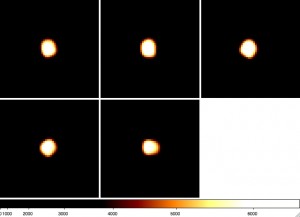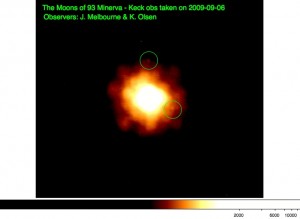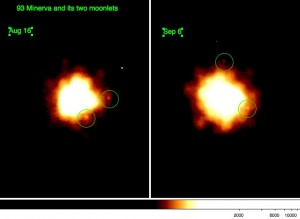Minerva and its two moons – confirmed!
Mount Wilson Observatory – saved and clean up time
September 6, 2009The Galileoscopes arrived – instructions and ideas for improvement
September 11, 2009Hello,
You may remember that I posted on my blog that we discovered a forth triple asteroid system in the main-belt. I submitted our discovery to the International Astronomical Union through a circular which was finally published on August 31.I am attaching the text of the circular since I am not 100% sure that everybody can access to the above link.
F. Marchis and B. Macomber, Carl Sagan Center at the SETI Institute and University of California at Berkeley; J. Berthier and F. Vachier, Institut de Mecanique Celeste et de Calcul des Ephemerides, Observatoire de Paris; and J. P. Emery, University of Tennessee, Knoxville, report that adaptive-optics images were recorded of (93) Minerva, a large C-type main-belt asteroid, with the 10-m Keck II telescope [+ NIRC2 camera (angular resolution up to 0".042, corresponding to a spatial resolution of 65 km) + Fe II filter (central wavelength at 1.64 microns)] between Aug. 16.57 and 16.64 UT, with the target at r = 2.117 AU and phase angle 20.0 deg. The direct images reveal that the large minor planet has an almost- spherical shape with an average diameter of 145 km. Additionally, these observations show the presence of a companion about 4 km in diameter at 0".41 (projected distance of 630 km) in p.a. 275 deg detected in every image recorded over the 1.8-hr baseline. Careful analysis of three images indicates the presence of a second satellite (about 3 km) and located closer to the primary at an apparent distance of 380 km (0".25) in p.a. 209 deg. With (87) Sylvia (cf. IAUC 8582), (45) Eugenia (cf. IAUC 8817), and (216) Kleopatra (cf. IAUC 8980), this is the fourth multiple system with two small-kilometer-sized satellites to be discovered and imaged in the main asteroid belt.

Resolved images of (93) Minerva primary observed with Keck AO from 13:36 to 15:25 UT on Aug 16. The primary is quite regular in shape.
First of all, as pointed by my colleague Alan Harris, there is a mistake in the circular. When I wrote “has an almost-spherical shape” , in fact I meant to say “has a projected circular shape“. The combined effects of the coming vacation and the tiredness due to the observation should be blame. I wanted to emphasize that in comparison with 87 Sylvia (which has a bean shape), and 216 Kleopatra (dog-boned shape), the shape of Minerva was quite regular over the 2h of our observations. The images on the left show a few the shape of Minerva’s primary.
Now we know that there are two moons around Minerva, it should be useful to determine the orbital parameters and compare them with the other known triple asteroid systems. Unfortunately, I do not have a 10m telescope equipped with state-to-the-art adaptive optics system in my backyard, so I really need to get more data from the Keck telescope itself. Since I do not have more telescope time and Minerva is getting closed to its opposition (closest to Earth, so the best time to observe the moons), I asked my colleagues who have observing time if they could record a few images of the asteroid. I emphasize that you really need a 8-10m class telescope with AO to detect the moonlet. The Hubble Space Telescope and its new instruments (WPC3, COS) may be able to detect it but I am not certain. The telescope is currently finishing its commissioning phase.
In my correspondence with my colleagues I promoted this observation mentioning that it will take less than 20 min of their telescope time and it is definitely a cool project for their student. I also prepare the observation, meaning that the command lines and ephemeris calculations are ready minimizing the amount of work for them.

93 Minerva observed at Keck II telescope by Jason Melbourne and Knut Olsen. The two moons are detected 🙂
I got a few positive answers and a few hours ago, Jason Melbourne, postdoctoral fellow at Caltech (Pasadena) and Knut Olsen, researcher at NOAO (Tucson) sent me data that they took a few days ago (Sept 6 UT). after basic data-processing, the image shown on the left and below reveals the presence of the two moonlets. This is a good news since it confirms the genuineness of our discovery. It is always good to have an independent confirmation. 🙂
By comparison with the data taken on Aug 16 UT, we can see that the satellites angular positions have changed significantly. However, they seem to be at the same angular distance implying that they system is most likely seen face-on. I am very thankful to Jason and Knut for having taken the time to observe Minerva during their night.
I asked for additional observations from other colleagues so I hope we will get more data to be able to derive the orbit characteristics, thus bulk-density, porosity and so on…
Clear skies,
Franck Marchis



